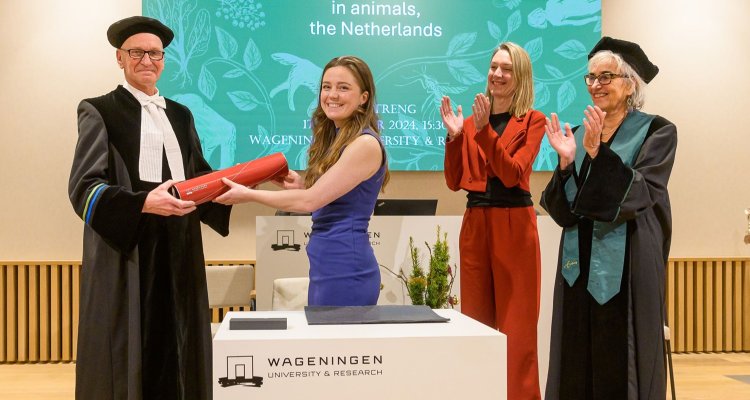
News
PhD researcher Kiki Streng of Wageningen University & Research: ‘Surveillance in animals contributes to pandemic preparedness’
Mosquito-borne zoonotic viruses are increasingly circulating in the Netherlands. PhD student Kiki Streng studied how surveillance systems can be improved to identify potential threats at an early stage and increase pandemic preparedness. One possibility for this is to use animals that are good indicators of pathogens that may pose a threat to humans. ‘Animals such as wild boars or chickens can help identify such threats,’ the researcher said. Streng successfully defended her PhD thesis at Wageningen University & Research on 17 December 2024.
Introduction and spread of new emerging zoonotic mosquito born viruses (MBVs) in moderate climates like the Netherlands will become more likely as climate, land use, travel and trade are changing rapidly. In her PhD thesis, researcher Kiki Streng of Wageningen University & Research focused on gaining insight in the epidemiological situation, (response) surveillance options and potential risk of mosquito born viruses in animals in the Netherlands, in order to inform future research and surveillance strategies. For this, she investigated the prevalence of some MBVs, such as West Nile Virus (WNV) and Usutu virus (USUV), and modelled the potential impact of environmental changes on these pathogens. The research also addressed the potential of certain species as sentinel animals, indicators for human health risks.
Role of animals
The (sero)prevalence of MBVs in the Netherlands is largely unknown. In a so-called serosurvey Streng revealed a very low seroprevalence of WNV and USUVs in both horses and dogs. “We found an observed seroprevalence of 0.27% for WNV in horses, and 0 % in dogs. For USUV the seroprevalence in dogs was 0.39% and 0 % in horses”, says Streng. In wild boars on the other hand, she found much higher proportions with neutralizing antibodies against WNV and/or USUV, already in 2018. “These findings suggest the presence of such viruses can remain undetected.”
Animals for surveillance
From a preparedness point of view, early detection of local MBVs circulation in (wild) animals would contribute to prevention and control strategies for both humans and animals. The use of (sentinel) animal species in MBV surveillance is based on the ability to detect infection before human cases appear. This would allow for a rapid response to prevent human disease and economic impact. “Some animal species are more likely to be useful as sentinels than others”, according to Streng. Also, the use of animals in a surveillance program is not evident, as active sampling of animals for surveillance requires ethical permission as it is considered an animal experiment. Streng therefore suggests testing of existing (biobanked) samples. “This may provide a more cost-effective solution and could lower animal discomfort.”
In her research Streng shows that wild boars could potentially be a good species for arbovirus surveillance. “These animals are already sampled on a regular basis for surveillance purposes of other pathogens, so it would not cause extra burden for the boars as such.” The downside for the Dutch situation, is the limited and very regional spread of wild boars.
Streng also sampled chickens in petting zoos and backyards to investigate their potential use in MBV surveillance in the Netherlands. Chicken sera were collected in two regions where WNV had been detected in 2020. “Results of this study indicate circulation of both WNV and USUV in 2021, as chickens seroconverted during this period. This circulation of WNV went undetected by other surveillance methods.” Furthermore, Streng found that USUV antibodies were waning off relatively fast, which indicates that chickens could potentially be reused as sentinels in the following season(s). According to the PhD researcher, petting zoo and backyard chickens thus seems a promising approach to detect virus circulation and potentially point towards public health risks.
Besides the studied species in her thesis, Streng suggests livestock and other animal species might be suitable for MBV surveillance. “The Netherlands has a very high livestock density. Further research is needed to investigate the use of domestic ruminants, pigs and poultry for zoonotic arbovirus surveillance.”
Future perspective
Most of the MBVs currently present in the Netherlands do not have a major impact on animal health. However, it is expected that due to changes in the drivers of emergence, new viruses will be introduced in the coming decades. “Even though zoonoses may be a part of the natural world around us, drivers of emergence of zoonotic MBVs are often related to human behavior. It is important to avoid creating a perfect habitat for emerging MBVs in a country with a high livestock density, many wetland areas and increasing human-wildlife-livestock interface.” According to Streng governments should anticipate and enhance preparedness, as outbreaks of MBVs are likely to become more frequent in the future. Dutch One Health stakeholders should thus, collectively, prepare response plans for outbreaks that are yet to come. “This also includes land use planning and climate adaptation decisions, as they have an effect on MBV outbreak risk. Effective policy decisions require not only scientific understanding but also informed public engagement, acknowledging the complexity of the risks. Only in this way, we can create a sustainable and healthy country for all ecosystems”, concludes Streng.